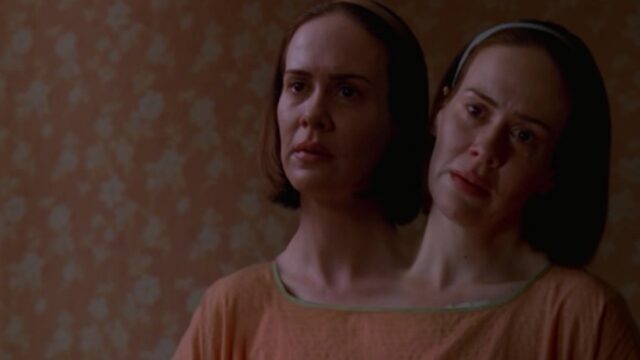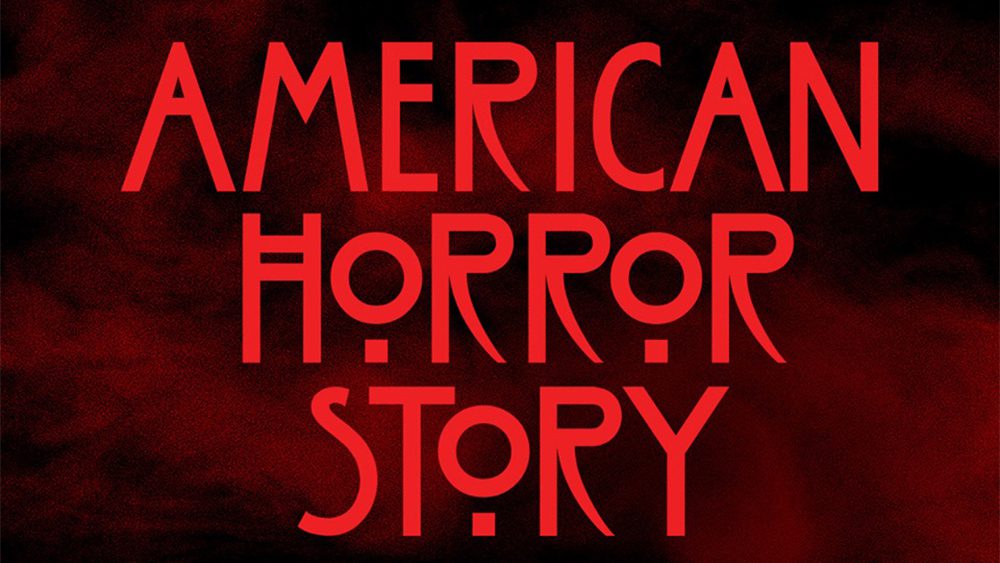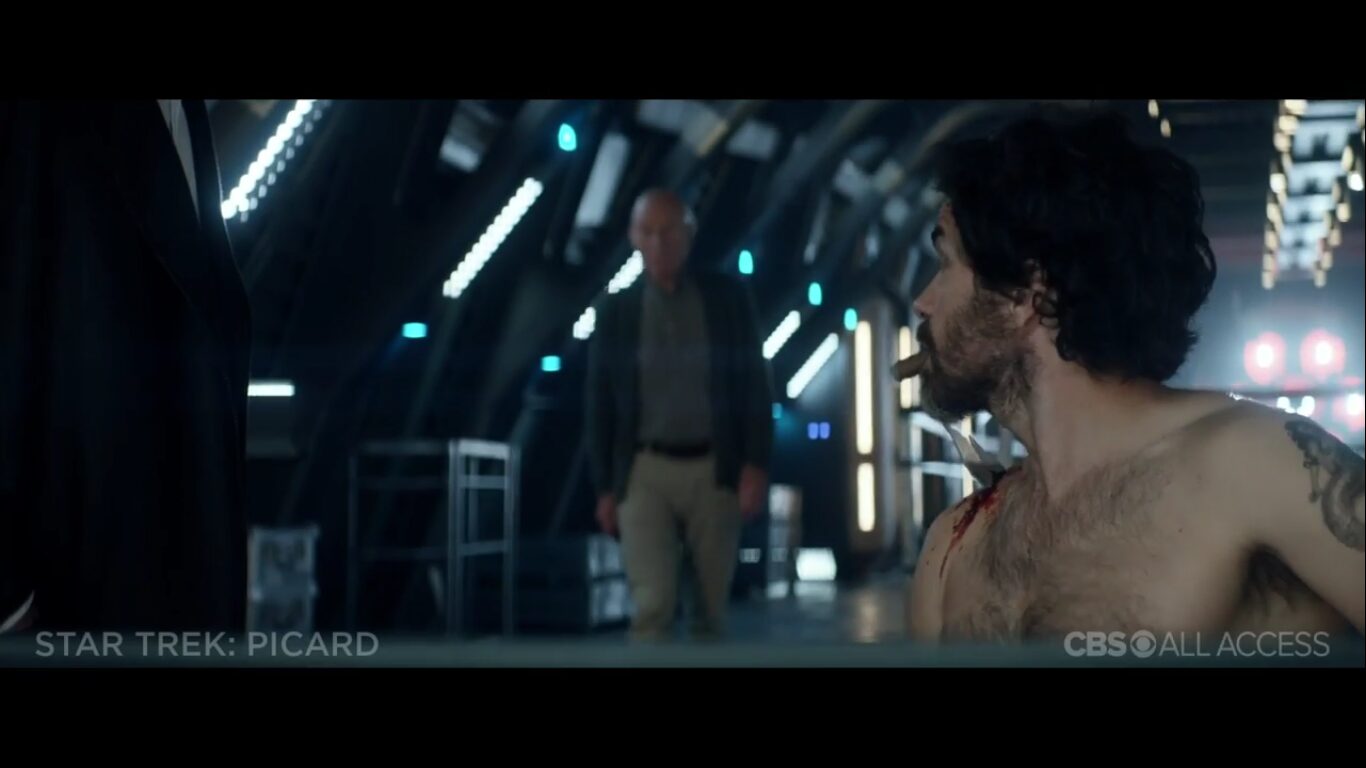I’ve loved Ryan Murphy’s American Horror Story since the very first trailer for the first season and have followed diligently every iteration of American Horror he as explored. And every time he finds a way to surprise you with a traditional beginning: a haunted house story that became a nightmare of modern marriage that led to ghosts who physically age and a murderous man in a leather gimp suit. The insane Asylum was next, weaving in tales of serial killers, media exploitation, homophobia, and anti-miscegenation, with fascist medical experiments and alien invasion. The third season, Coven, tackled witches and themes of mental, physical and sexual abuse of children and adults alike, and the torturous history of slavery in the south.
Through all of these anthologies is the constant presence of the fabulous Jessica Lange, still game to play empress of these visions (one last time she has said) of the horrors still prevalent in American society. As has become customary, her imperious character at the center of each theme, seemingly amoral queens of their respective milieus, have a hidden tortured past and a bombastic DGAF attitude in the present, before characters possessing comparable influence threaten her throne and humanize her once more.
Also back is Ryan Murphy’s male muse Evan Peters, who always happily winds up in some state of undress and/or creepy eroticized scenario (the gimp suit in the first AHS, the bare-ass caning and occasional bondage in Asylum, the Frankenstein’s monster threeway in Coven). They rejoin fellow AHS repertory original Frances Conroy, the newest returning members Kathy Bates and Angela Basset, and the always brilliant Sarah Paulson, back for her third time.
Another of my favorite elements of this show that I was almost the most excited to see, are the opening credits sequences. Each season it’s an avant-garde film inspired by the central horror of the title, and they have never failed to haunt my dreams. I think I may love this year’s as much as the one for Asylum, which is easily the scariest of all of them, and I will not be fast-forwarding through it every week to get to the episode. This may seem pointless, but the more you watch these as the season goes on, the more ideas and details you notice in them, and I’m excited to see what else emerges with repeat viewings. The stop-motion animation and the carnival aesthetics mixed with the demented imagination producing these free-association images strikes the exact right tone for this season’s paean to antiquated macabre. It’s like The Nightmare Before Christmas met The House of 1,000 Corpses.
This time around the setting is a carnival Freak Show, a theme that was brilliantly utilized in HBO’s sadly cancelled Carnivale. It remains to be seen if Murphy’s new work is more indebted to that show rather than Tod Browning’s Freaks, but either way I like what I see so far. Lange plays Elsa Mars (a name which instantly reminds of Ilsa the She Wolf) the Teutonic grand master of her side attraction and its stars: the deformed members of the human race whose very image terrifies the “normal” by merely existing. American Horror Story: Freak Show is set at a time when television has threatened those forms of entertainment that require one to leave the house. The show creates a perfect blend of elements that would cause characters of the ’50s to be cautious about who or what they open their philosophical doors to in the outside world, and luckily technology has now enabled them to receive entertainment by staying in. But Elsa is desperate to find an audience for her talents again, and will not let anything stop her. By inverting the real horror of living in America through the horror genre, Murphy speaks to the ostracism of those who are perceived as being not what nature intended, and TV as capitalizing on the growing American fear of life outside our own immediate spheres. By further isolating themselves from one another they make themselves easy victims, of mockery and fictitious psychos.
Elsa is a former star aus Deutschland now clipping Marlene Dietrich’s reviews from newspapers and making her living on the hunched backs of her “monsters” (a term used in the same affectionate intention as Lady Gaga’s name for her fans) whom she fiercely protects against the discrimination of their current market-Jupiter, FL. She also uses this discrimination to emotionally manipulate them to keep them in her employ. The world outside their sphere doesn’t make her job of manipulating them very hard. But Peters’ “Jimmy Darling,” the son of Elsa’s right hand woman/Bearded Lady (Bates, with a Baltimore accent??), at least has his own side business… as a private attraction for Betty Draper-clad parties of women who have to cope with the dull listless husbands who prefer “turning on Dragnet and climbing on top of” them, to helping them achieve orgasm. His lobster claw hands prove to be quite the pleasant shocker awaiting them at the end of the long dark and winding back halls of suburban homes in the middle of the day.
To begin the episode however is the voiceover of Sarah Paulson as Dot, recounting in the past tense a woeful tale of how she wound up in Elsa’s rag-tag family, as we see her approach the entrance gate to the Cabinet of Curiosities. The time warp of the whole episode begins here with this literal beginning point. What we see is actually the chronological middle of the first episode’s, and the season’s, story. Elsa needs a new act to perk up flagging sales, but the story begins with this flashback from the middle to how the savior(s) of the freak show came into Elsa Mars’ orbit. A milkman approaches a farmhouse and notices his previous delivery is curdling in its unopened bottles on the porch. Guarding himself with a rolling pin as he goes inside and bravely investigates his customer’s displeasure with his product, he finds a bloody corpse and someone in a closet whom we don’t see.
This episode teases out the full view of Paulson’s conjoined twins, revealing her first through the physical revulsion of other people to them; like the milkman screaming louder at seeing the twins than seeing a dead body, the nurse running out of the ER to vomit in a trash can, and the nurse reviewing the x-rays showing multiple sets of organs. Someone has also stabbed the twins, but Elsa knows they did it to themselves since doctors can already tell this wound occurred after the death of their mother. Our first full view of Dot and her sister Bette, is Elsa’s first view as filtered through her perspective: their hospital bed aglow in angelic splendor behind the curtain, as she has followed the papers on the farmhouse murder and tracked down these potential additions to her collection of performers. Side note-the use of identical images as splitscreens to show us how the twins see the world is an interesting choice which I hope may lead to more playful variations on the world as seen through their two sets of eyes.
Paulson is perfectly delineating distinct but complementary personalities for each character. She displays a furrowed brow, tightly pursed lips, and harsher vocal tone for the one with a more hardened exterior (Dot the right brain), the protector who bottles her emotions and fiercely holds the reigns in the twin relationship (she’s the one who stabs Bette in frustration). She uses softer eyes, parted pouty lips and a breathy higher-pitched voice for the other twin, more of a dreamer and innocent who gives in to feeling (Bette, the left brain), the one who loves the movies (hearing her plead to see Singin in the Rain “in glorious Technicolor!” is both humorous and sad at the same time as it prompts Bette’s murder of their mother) and also masturbates for the both of them (which Dot says makes Bette a slut since she is playing with Dot too).
Since they’re already perceived as monsters because of their physical state, and are suspects in their mother’s death, Elsa uses this to convince them to come with her. And for good measure, she takes a bitchy candy striper from the hospital whom she overhears speaking ill of the twins, and Shanghai Gesture‘s her, setting up another potential subplot of interest for the rest of the season.
But let’s talk about the clown (played by John Carroll Lynch, the sweet painter husband to the pregnant police chief in Fargo, who has gone on to play a succession of creepy characters since). Meanwhile, there is a killer clown that has started terrorizing Jupiter, FL at the same time. Clowns are already frightening, not to mention that It and John Wayne Gacy didn’t do much to change that perception. I realize it’s shooting fish in a barrel to make a clown murderer creepy, but I have to hand it to Lynch, Murphy and co. A great actor, visual concept and great make-up artistry can do wonders with a classic idea: Lynch’s movement, the filthy clown costume, the bald human scalp headpiece with three upright tufts of dirty colored hair, combined with oversized demented Joker-smile mask and crusty black and white face-paint was enough on its own to complicate my restful sleep that night.
His introduction during a bucolic lakeside picnic for a romantic couple, straight out of the opening of Blue Velvet, baffled until the tension reached its fruition and gets violent. As the boyfriend is in the car, the sweet idiot blonde girl he’s with just stands and stares quizzically at the disturbed clown coming towards her. One look at this guy’s profile from far away was enough to know not to stick around. But she waits for him to come over instead of running the fuck away! She may not have been reared on as many horror movies as I have. However, I can’t imagine any human biological instinct that has evolved to interpret this guy’s look as anything other than a threat to staying alive. When the boyfriend comes back and is properly horrified (“You didn’t hire him?” the stupid girlfriend asks-who would hire this clown for light-hearted entertainment woman?!) “Twisty the Clown” knocks them both out with his juggling pins. Girlfriend awakens to the sound of her boyfriend’s death rattle as the clown is repeatedly plunging a knife into his chest (kudos to the sound mixer on this scene). She FINALLY decides to run away, but is easily retrieved having recently been concussed just a few minutes earlier. We catch up with the clown again as he hits up a family home, murders the parents and takes the son with him.
We later learn the kidnapped boy and the girlfriend are both alive (now free of their protective caretakers), and not at all well (living in locked cages inside his trailer). The girlfriend’s desperate and unconvincing plea to let them free because “you’re so talented, we want to tell the world” is so cringe-worthily hopeless that even the clown laughs at her. We learn how unbelievable her tearful assessment of his talents are when even doing happy clown things is a source of horror with this guy. The captives react in terror, crawling into the corners of their cages and burying their heads in their hands, as he begins to make a balloon animal, which seems an odd reaction at first. Apparently he has tried this enough times already before and they know it’s going to end poorly, which it does when he pops the balloon and reacts by traumatizing them with his rage-fueled tantrum for witnessing his failure.
This subplot makes things difficult for the Freak Show, which we discover when they hang a banner advertising their new headlining Siamese Woman act. A detective notices instantly that they are the suspects in their mother’s murder, and finds them. As he threatens that they might be suspects in the other murders (which we know are committed by Twisty) Jimmy Darling comes in with the other members of the show, and bristling at being called freaks after a whole episode of this, slices the detective’s throat. The little monsters band together under Jimmy’s rousing speech about fighting back against their poor treatment. He despairs over being part of a group that everyone else feels comfortable abusing, and together they dismember the body… with an audience of one looking on from the background-the angry clown, seemingly upset that he has competition in the murder game. This scene is intercut with the performance that follows in actual time-of the Freak Show itself, for an equally unsettling small audience-of two elegantly dressed people: an overbearing mother and spoiled adult son eager to see the freaks in Jupiter.
Naturally in this spacey locale, Elsa comes onstage riding a painted cutout of a spaceship in a lady tuxedo pantsuit and pale blue eye-shadow, singing David Bowie’s “Life on Mars?,” further underscoring the time-warp that the show exists in. As the song tells us, it’s a freaky show, and judging from the preview of the rest of the season, will continue this anachronism in their musical choices. Here, it works in the sense that Elsa appears to be asking herself if she has any life left, or if the future (from which the song emanates) holds any life for her. The time skipping doesn’t stop there as her performance also harkens back in time to when many people were sold as property, be they freaks or slaves. She refuses to sell Dot and Bette to the rich mother (Conroy) who offers thousands of dollars for them as a present for her grown son, who wants his own freak as a toy no one else has. Elsa’s reasoning is not only that they are a chosen family that she will not break up, but that Dot and Bette are going to make her big money as her headliners (something that matters to Bette more than Dot, but both need the protection of their family after the group efforts earlier in the evening). Elsa seems particularly stung by Conroy’s retaliatory barb that her singing was the most freakish thing on stage. This is not the last we’ve heard of this strange mother/son pair.
It’s not until Elsa undresses in her tent to the record player spinning music clearly tied to the time in which she lives, that we understand. She starts to remove her stockings and knobs are suddenly visible as she keeps undressing her legs until she takes them off too, and her face tells us something about this infirmity still haunts her too. We discover that she really is one of her sideshow family, not a grizzled showbiz pro who has made pets of her employees. From this reveal, we can assume she may not have been relegated to the Freak Show business because she lost her looks and burned her bridges, but perhaps out of necessity this is the only corner of entertainment left to her? What happened is not revealed, but will surely come to light and inform her character throughout AHS: Freak Show.
Ryan Murphy has now somehow earned license to do something no one thought was possible since the notorious Tod Browning earned hell-in-a-handbasket status from Hollywood when he made Freaks in 1932: casting actors according to their physical difference to play “themselves” as circus freak characters in a fictionalized horror story. Perhaps because of Murphy’s history of respecting actors with disabilities by showcasing their abilities, I have heard relatively little uproar over Murphy’s cast that includes a Lilliputian Indian (Jyoti Amge, the world’s smallest living woman), a woman with no lower body who walks on her hands, a man with shrunken forearms, and an almost 7-ft actress as “Amazon Eve.”
Though the script for this season premiere is rife with hamfisted dialogue about prejudice and TV sucking up the customers, it actually feels like a layer of the show that hasn’t fully been peeled away yet. We now live in an age where there is always a network for people to share their unique abilities with the world through reality TV (such AMC’s Freakshow or shows like Oddities). To be an attraction, they have to be rarefied, and largely inaccessible. Yet invisibility also helps to hold them back socially and financially. For sure Murphy will play with our heart rates and psyches as much as with the questions of exploitation vs entertainment to take our discomfort to a deeper level throughout the season. As a TV version of Barnum and Bailey Murphy has set up quite a series already. And we haven’t even met all of the characters yet!







